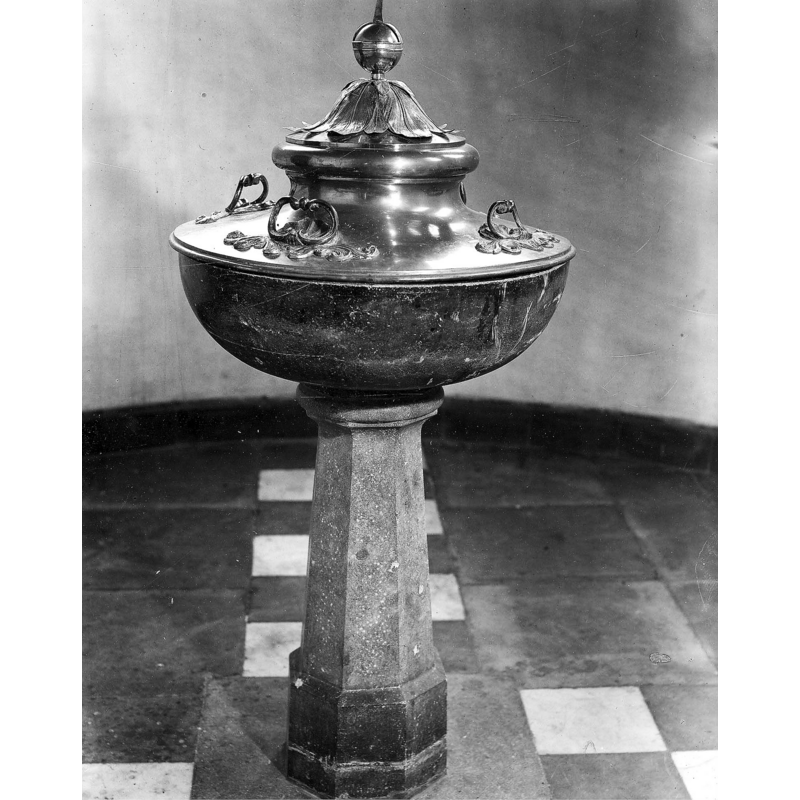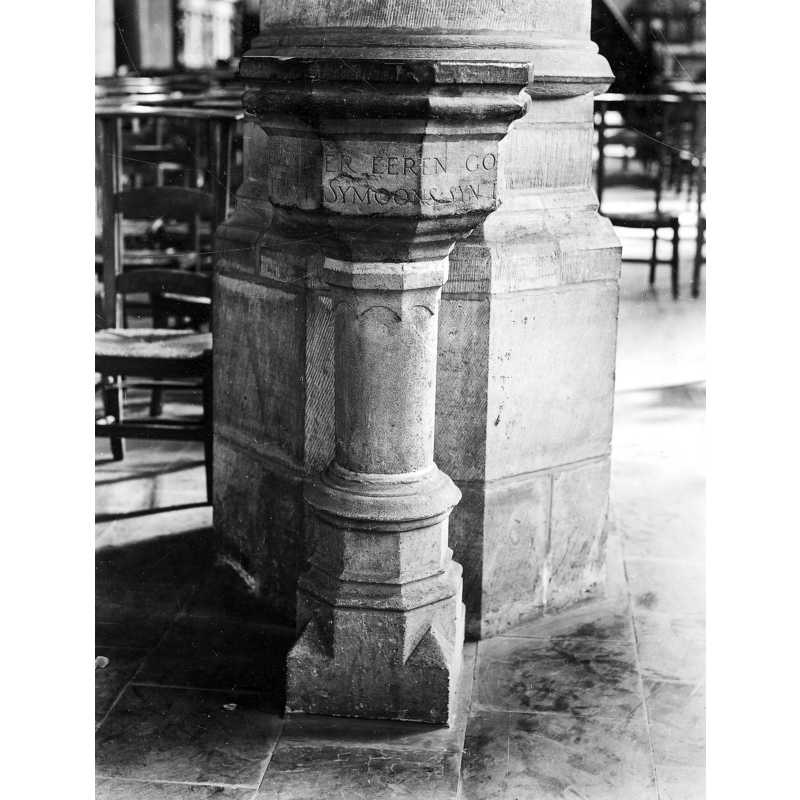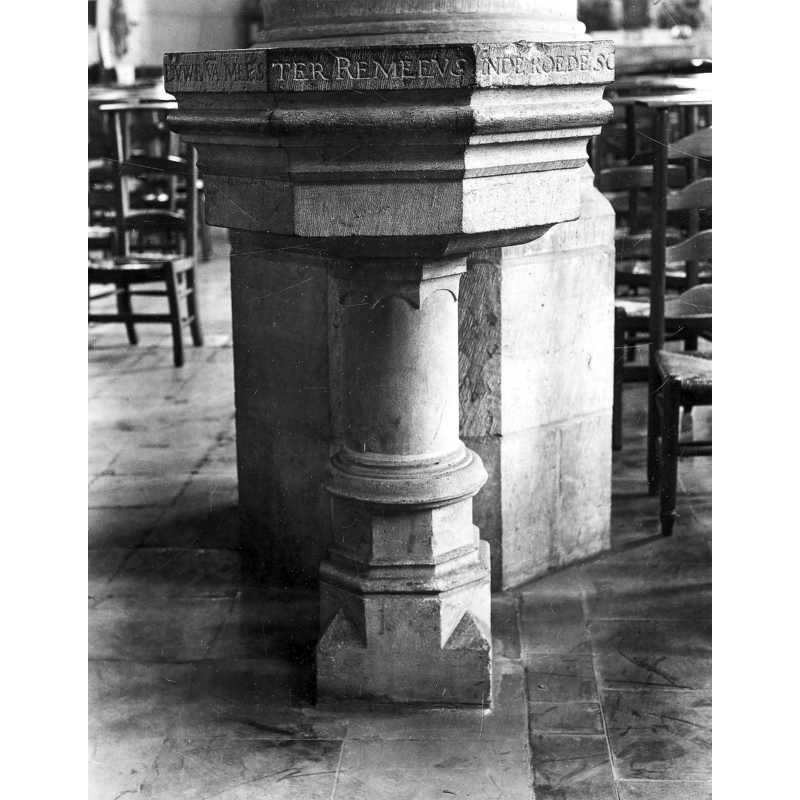Kontich / Condacum

Image copyright © KIK-IRPA, Brussels (Belgium), 2023
Reproduced in accordance with KIK-IRPA guidelines
Results: 8 records
animal - fabulous animal or monster - dragon?
Scene Description: only the curved tail of a likely dragon has survived, the curls of a mane visible on the left
Copyright Statement: Image copyright © Kring voor Heemkunde / Museum Konicht, 2023
Image Source: digital photograph credited to the Kring voor Heemkunde in the Museum site [https://www.museumkontich.be/Sprokkels/Romaanse doopvont.htm] [accessed 19 October 2023]
Copyright Instructions: PERMISSION NOT AVAILABLE – IMAGE NOT FOR PUBLIC USE
animal - mammal - lion - passant-gardant
Scene Description: the turned [gardant] head, the curly mane and the tail curved above its rump are clearly those of a typical Romanesque lion
Copyright Statement: Image copyright © Kring voor Heemkunde / Museum Konicht, 2023
Image Source: digital photograph credited to the Kring voor Heemkunde in the Museum site [https://www.museumkontich.be/Sprokkels/Romaanse doopvont.htm] [accessed 19 October 2023]
Copyright Instructions: PERMISSION NOT AVAILABLE – IMAGE NOT FOR PUBLIC USE
view of basin - fragment
Copyright Statement: Image copyright © Kring voor Heemkunde / Museum Konicht, 2023
Image Source: digital photograph credited to the Kring voor Heemkunde in the Museum site [https://www.museumkontich.be/Sprokkels/Romaanse doopvont.htm] [accessed 19 October 2023]
Copyright Instructions: PERMISSION NOT AVAILABLE – IMAGE NOT FOR PUBLIC USE
view of church exterior - southwest view
Scene Description: Source caption: "Kontich (prov. Antwerpen, België). Sint-Martinuskerk." [NB: the present St Martin's parish church, originally dedicated to St maty; it replaced the original St Martin's parish church when the latter was demolished in the 17thC]
Copyright Statement: Image copyright © [in the public domain]
Image Source: digital photograph 8 August 2015 by Torsade de Pointes [https://commons.wikimedia.org/wiki/File:Kontich_Sint-Martinuskerk_1.jpg] [accessed 19 October 2023]
Copyright Instructions: CC-Zero
view of font and cover
Scene Description: the modern font of 1873 in this church
Copyright Statement: Image copyright © KIK-IRPA, Brussels (Belgium), 2023
Image Source: digital image of a 1943 B&W photograph [B050209] by the Commissariaat Generaal voor 's Lands Wederopbouw [https://balat.kikirpa.be/object/63656] [accessed 19 October 2023]
Copyright Instructions: Reproduced in accordance with KIK-IRPA guidelines
view of holy well in context
Scene Description: said to be the original location of a holy well known as "Sint-Martinusput", in Kontich
Copyright Statement: Image copyright © Kring voor Heemkunde / Museum Konicht, 2023
Image Source: digital photograph credited to the Kring voor Heemkunde in the Museum site [https://www.museumkontich.be/Sprokkels/Romaanse doopvont.htm] [accessed 19 October 2023]
Copyright Instructions: PERMISSION NOT AVAILABLE – IMAGE NOT FOR PUBLIC USE
view of stoup in context
Scene Description: Source caption: "datering, gebeiteld, bovenaan: schenkingsinscriptie: DIT HEEFY GEGEVEN TER EEREN GODTS REMEEUS PHLUS ... Ao 1573"
Copyright Statement: Image copyright © KIK-IRPA, Brussels (Belgium), 2023
Image Source: digital image of a 1943 B&W photograph [B051061] by the Commissariaat Generaal voor 's Lands Wederopbouw [https://balat.kikirpa.be/object/63744] [accessed 19 October 2023]
Copyright Instructions: Reproduced in accordance with KIK-IRPA guidelines
view of stoup in context
Scene Description: Source caption: "datering, gebeiteld, bovenaan: schenkingsinscriptie: DESEN FUENTEN HEEFT GEGEVE TER EERRE GODTS DIE ... Ao 1574"
Copyright Statement: Image copyright © KIK-IRPA, Brussels (Belgium), 2023
Image Source: digital image of a 1943 B&W photograph [B051062] by the Commissariaat Generaal voor 's Lands Wederopbouw [https://balat.kikirpa.be/object/63746] [accessed 19 October 2023]
Copyright Instructions: Reproduced in accordance with KIK-IRPA guidelines
INFORMATION
FontID: 25000KON
Object Type: Baptismal Font1 (fragment)
Museum and Inventory Number: Museum voor Heem- en Oudheidkunde, Kontich
Church/Chapel: Sint-Martinuskerk, parochiekerk Kontich
Church Patron Saints: St. Martin of Tours [originally dedicated to St. Mary]
Church Location: Gemeenteplein 15, 2550 Kontich, Belgium -- Tel.: +32 3 457 46 21
Country Name: Belgium
Location: Antwerp, Vlaanderen / Flandres
Directions to Site: Kontich is located E of the N171 and the E19, 10-12 km S of Antwerp city centre
Ecclesiastic Region: [Roman Catholic Diocese of Antwerp]
Font Location in Church: [in a museum]
Date: n.d.
Workshop/Group/Artisan: Tournai font?
Cognate Fonts: the font at nearby Hove? [cf. FontNotes]
Credit and Acknowledgements: We are grateful to Pol Herman for bringing this font and holy well to our attention and for his help in documenting them
Church Notes: two medieval churches very close to each other are noted in Kontich; the oldest was St Martin's (near today's Sint-Martinusplein). demolished in the 17thC; materials including fragment of the baptismal font used in the construction of a new farm (now the 'Oude Eendracht' café) -- the 2nd church of ca. 1088-1149 was dedicated to St Mary, later re-dedicated to St Martin when the older church was demolished and St Mary's became the main parish church; destroyed in 1572; restored in 1604; much modified since
Font Notes:
Click to view
Noted and illustrated in the Jean-Claude Ghislain's Les fragments de fonts baptismaux romans tournaisiens de Kontich et de Hove (1988). The entry for the nearby church in Hove nr. Antwerp in the Hove.be site [https://www.hove.be/romaanse-doopvont-sint-laurentiuskerk] [accessed 18 October 2023] informs that the fragment of the medieval font originally from Kontich St. Martin's demolished church is similar to the medieval font discovered in Hove in 1968 [cf. BSI entry for Hove nr. Antwerp]. Noted and illustrated in Frank Hellemans en Guido Pede, with photographs from Kring voor Heemkunde, Herwerkte en uitgebreide versie van een artikel uit het Informatieblad van de gemeente Kontich, september 2001, as a fragment of a 12th-century Tournai font now in the MuseumKontich [https://www.museumkontich.be/Sprokkels/Romaanse doopvont.htm] [accessed 19 October 2023]; the fragment was discovered built into the foundations of 'De Oude Eendracht' pub on Rubenstraat when it was being demolished. The surviving fragment is a corner of the square basin of a table-top type Tournai-type font; its decoration includes part of a passant-gardant lion and a part of a dragon, only part of the mane and the curved tail of the latter showin. The present font in this church is listed in BALaT KIK-IRPA [https://balat.kikirpa.be/object/63656] [accessed 19 October 2023]; modern, of 1873 [cf. ImagesArea]. Two more entries in BALaT-KIK IRPA [https://balat.kikirpa.be/object/63744] and [https://balat.kikirpa.be/object/63746] [accessed 19 October 2023] lists and llustrates two late-16th century stone holy-water stoups in this church. The Museum entry above mentions a baptismal well [near the Nachtegaalwijk], that is said to have been used for baptisms in early times; its water was said to have curative powers.
A communication to BSI from Pol Herman (e-mail of 5 November 2023) provides backgound information on the churches of Kontich and the origins and happenings of the font: "The village of Kontich had two churches (Saint-Martin and Our Lady), barely a stone's throw from each other, because its territory fell under two jurisdictions : the land of Rijen (duc of Brabant) and the land of Mechelen (also called land of Arkel, noble family of the Berthouts). The oldest church, which has since disappeared, was Saint-Martinus. It was located on the current St. Martin's Square with an extensive cemetery surrounding it. Originally, it was a simple church largely built of wood and covered with a thatched roof. The building of a Romanesque stone church (façade ?) was later started, but never finished. Parts of the wooden building were never replaced, and the roof was never tiled.
According to tradition, Saint Reinildis came from Kontich. Although this has been refuted by historical sources, it is certain that this niece of Pepijn van Landen owned land here, which she donated to the abbey of Lobbes in Hainaut around the 7th century. However, due to the raids of the Vikings, the abbey lost control over its property. In the year 1088 Lobbes was able to realize the first partial recovery of the Kontich parish. Nicolas Claret, the bishop of Cambrai reconfirmed in 1149 that the church of Kontich was the property of Lobbes. This meant that they could appoint the pastor and collect the tithes through him. Probably at that time, a Tournai-type baptismal font was donated. A second, more complete restitution followed in 1249. The church burned down completely in the years 1538-1556. Was it caught in the flames during the great fire that swept through the village on April 23, 1538? Was it set on fire in 1542 during Maarten van Rossem's disastrous passage through our region? The archives tell us nothing about the exact date and cause of the fire. And apparently there was no haste with the reconstruction of the church. After the iconoclastic fury of 1566, all plans to restore the St. Martin's Church were definitively abandoned. The name of the patron saint and the worship were transferred from the oldest church to the more recent church of Our Lady. Around the end of the 17th century, the ruins of the old church were demolished. The debris (including fragments of a baptismal font) were recycled and used for the construction of a farm on the same location (the later pub 'Oude Eendracht', the local seat of the mediaeval crossbow guild). Hardly any remains of the church were found later. What is certain is that the church and cemetery were located outside the present-day village centre. A small chapel dedicated to Saint-Martin was erected in the vicinity of the former ruins as compensation, but that in turn disappeared in 1863. The fragment of the Romanesque baptismal font was discovered when the pub was demolished in 1979. It is now at the local museum in Kontich."
A communication to BSI from Pol Herman (e-mail of 5 November 2023) added information about a holy well, "Sint-Martinusput", in Kontich: "Said to be the location where people were baptized during the Christianisation of the area. According to the legend, this source probably dates back to pagan times. However, the existence of this well was only first mentioned in 1648. At the end of the nineteenth century, the baptismal well was somewhat forgotten by the population. It was rediscovered in 1948 by the local priests. But this rediscovery is relative, because the local population always knew that place, even if only as a watering place for cattle. The children went there to catch fatheads, salamanders and sticklebacks."
COORDINATES
Church Latitude & Longitude Decimal: 51.13505, 4.44548
Church Latitude & Longitude DMS: 51° 8′ 6.18″ N, 4° 26′ 43.73″ E
UTM: 31U 601132 5665837
MEDIUM AND MEASUREMENTS
Material: stone, limestone (black and blue) (Tournai marble)
Font Shape: [fragment]

![Source caption: "Kontich (prov. Antwerpen, België). Sint-Martinuskerk." [NB: the present St Martin's parish church, originally dedicated to St maty; it replaced the original St Martin's parish church when the latter was demolished in the 17thC]](/static-50478a99ec6f36a15d6234548c59f63da52304e5/compressed/1231019001_compressed.png)

